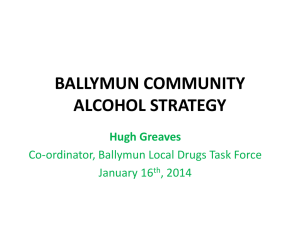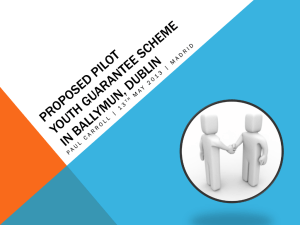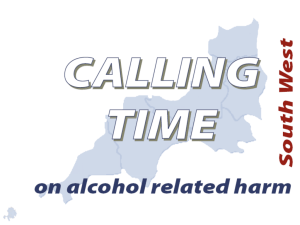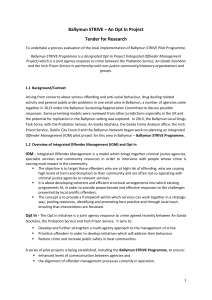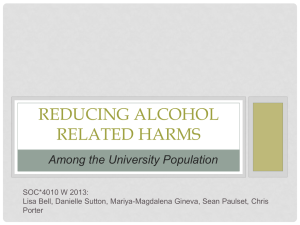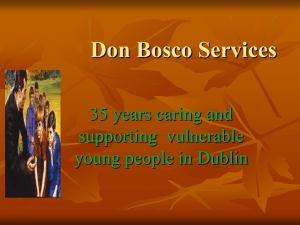Presentation to Oireachtas Joint Committee on Health and Children
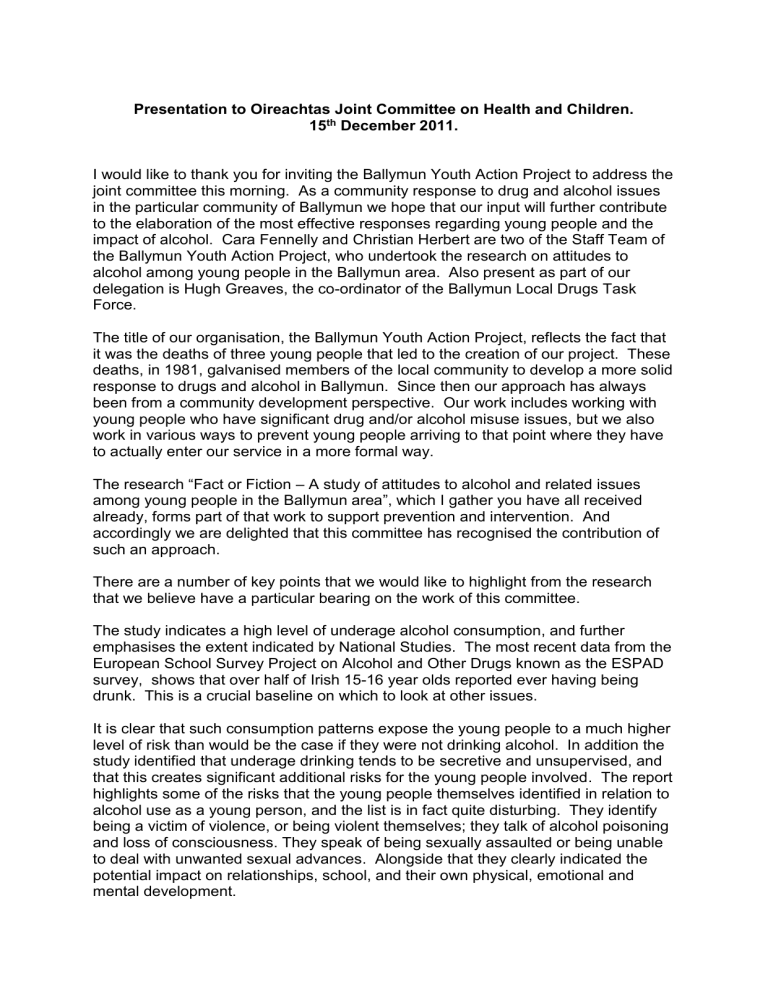
Presentation to Oireachtas Joint Committee on Health and Children.
15 th December 2011.
I would like to thank you for inviting the Ballymun Youth Action Project to address the joint committee this morning. As a community response to drug and alcohol issues in the particular community of Ballymun we hope that our input will further contribute to the elaboration of the most effective responses regarding young people and the impact of alcohol. Cara Fennelly and Christian Herbert are two of the Staff Team of the Ballymun Youth Action Project, who undertook the research on attitudes to alcohol among young people in the Ballymun area. Also present as part of our delegation is Hugh Greaves, the co-ordinator of the Ballymun Local Drugs Task
Force.
The title of our organisation, the Ballymun Youth Action Project, reflects the fact that it was the deaths of three young people that led to the creation of our project. These deaths, in 1981, galvanised members of the local community to develop a more solid response to drugs and alcohol in Ballymun. Since then our approach has always been from a community development perspective. Our work includes working with young people who have significant drug and/or alcohol misuse issues, but we also work in various ways to prevent young people arriving to that point where they have to actually enter our service in a more formal way.
The research “Fact or Fiction – A study of attitudes to alcohol and related issues among young people in the Ballymun area ”, which I gather you have all received already, forms part of that work to support prevention and intervention. And accordingly we are delighted that this committee has recognised the contribution of such an approach.
There are a number of key points that we would like to highlight from the research that we believe have a particular bearing on the work of this committee.
The study indicates a high level of underage alcohol consumption, and further emphasises the extent indicated by National Studies. The most recent data from the
European School Survey Project on Alcohol and Other Drugs known as the ESPAD survey, shows that over half of Irish 15-16 year olds reported ever having being drunk. This is a crucial baseline on which to look at other issues.
It is clear that such consumption patterns expose the young people to a much higher level of risk than would be the case if they were not drinking alcohol. In addition the study identified that underage drinking tends to be secretive and unsupervised, and that this creates significant additional risks for the young people involved. The report highlights some of the risks that the young people themselves identified in relation to alcohol use as a young person, and the list is in fact quite disturbing. They identify being a victim of violence, or being violent themselves; they talk of alcohol poisoning and loss of consciousness. They speak of being sexually assaulted or being unable to deal with unwanted sexual advances. Alongside that they clearly indicated the potential impact on relationships, school, and their own physical, emotional and mental development.
The study shows the central role that parents/guardians play in all of this. The young people surveyed give clear indications that they want parents to know what is going on, and that such parental knowledge would in fact be a protective factor. They are also very aware of the impact that adult behaviour around alcohol has on young people. Digging deeper into this finding, it appears that there are two dimensions emerging. Firstly, parents clearly have a role in modelling behaviours around alcohol, even down to such things as not becoming drunk in front of children. A 2010
Study of Family Life and Alcohol Consumption, by the Joseph Rowntree Foundation, found that it is parents who are the most important influence on young children’s
(aged 5-12) attitudes towards alcohol. Secondly, many parents are also engaged in a process of colluding with the secretive drinking behaviour of the young people, motivated in part by a desire not to know that it is going on in the hope that it will settle down, and “sure didn’t we all do it” attitudes.
However the young people were clearly saying that it would be better if parents did know about the drinking of their children.
In the study there is a clear awareness among the young people of the negative impact of alcohol, particularly when the amount or pattern of drinking leads to negative outcomes. There was also a consensus that advertising doesn’t adequately represent this. In their responses, the young people in the study highlight a dilemma that clearly exists but that is not very frequently discussed in the policy arena. This is the tension between presenting “responsible drinking” messages to young people where the legislation states that they should not be drinking in the first place. From the young people’s perspective the over focus on extreme case scenarios does not seem to offer them any guidance, and in many cases may simply invoke the “that would never happen to me” defensive reaction.
Such considerations lead us back to the issue of reducing the harm involved for the young people. Harm reduction is a recognised public health strategy, yet when it involves our young people it generates strong reactions. Clearly it is not appropriate that young people consume alcohol, yet they are doing so. In the absence of accurate messages their consumption is more likely to be harmful. We need to access ways of making these accurate messages available, looking particularly at the medium more than the message. A 2009 World Health Organisation publication on Reducing Alcohol Related Harm, identified that surveys of particular population groups, such as adolescents, are particularly useful in designing effective alcohol education and information programmes targeting the particular groups. Parents and peers have emerged from the Ballymun study as key agents in getting this accurate information across, and also as key actors in keeping the young people safe.
Clearly not every young person who drinks alcohol before the age of 18 will develop a dependency on alcohol, but they are still at risk of harm, and this harm is accentuated by the type and amount of alcohol consumed, and the context in which the consumption occurs. As a community response we are attentive to both the young people who progress into dependency, and the much larger group who continue to be at significant risk of harm in the present moment. Accordingly we support any initiatives that would actually reduce the level of consumption, and that would serve to make the context where young people grow up more communicative,
and more supportive of positive outcomes in relation to physical and mental health and wellbeing.
The Ballymun Local Drugs Task Force, which is represented here by Hugh Greaves, are also working in a systematic way, with a whole range of community and statutory partners, to bring about a change in the local environmental and community systems which currently facilitate harmful levels and patterns of drinking in Ballymun. This work is captured in the Ballymun Community Alcohol Strategy 2010-
2016 titled “A
Road to Change”. The strategy proposes that a number of areas must be addressed locally to achieve a reduction in harm; including regulating the numbers/ density of alcohol retail outlets, policing and enforcement, community awareness and attitude change, education, treatment and harm reduction.
Two of the key principles underpinning the strategy are important to highlight here in the context of this committee. Firstly the strategy recognises that alcohol is not an
“ordinary commodity” but a powerful intoxicant proven to be causative in a number of health and social harms. Secondly the strategy endeavours to reduce alcohol related harm by reducing overall consumption levels. These principles are particularly relevant to our discussion this morning.
The members of the Ballymun Local Drugs Task Force have long recognised the significance of the supply of alcohol to young people in terms of addressing the broader issue of the harms associated with its use. Accordingly the Strategy advocates for the cessation of alcohol home deliveries and text sales; the cessation of alcohol price reduction promotions, and the introduction of minimum pricing standards. The strategy also continues the work of the Task Force in challenging the practice of adults buying for minors.
In conclusion, the experience within the community of Ballymun strongly suggests that alcohol related harm is a feature of the life of young people growing up here.
Tackling that harm needs to involve a systemic response that addresses all of the contributory factors. Drawing parents and young people as peers more closely into that response does appear to be an underused avenue. And finally, it is clear that the drastic cuts that have been applied to the youth sector in this budget, will undoubtedly have an additional impact on alcohol related harms as they affect young people.
